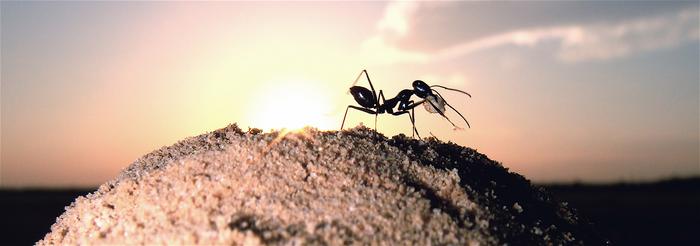Desert ants have outstanding navigational skills. They live in the saltpans of North Africa, an extremely inhospitable environment. To find food for their nest mates, foraging ants have to walk far into the desert. Once they have found food, for example a dead insect, their actual problem begins: How do they find their way back to their nest as quickly as possible in the extremely hot and barren environment? “The desert ant Cataglyphis fortis stands out due its remarkable ability to successfully navigate and forage in even the harshest environments, making it an excellent subject for studying the intricacies of navigation. With an innate navigation mechanism called path integration, these ants use both a sun compass and a step counter to measure the distances they cover. In addition, they possess the ability to learn and utilize visible and olfactory cues. We believe that this extremely harsh habitat has led, during evolution, to a navigation system of unsurpassed precision,” said Marilia Freire, the study’s lead author, summarizing what is known so far about the amazing orientation skills of these small animals.

Credit: Markus Knaden, Max Planck Institute for Chemical Ecology
Desert ants have outstanding navigational skills. They live in the saltpans of North Africa, an extremely inhospitable environment. To find food for their nest mates, foraging ants have to walk far into the desert. Once they have found food, for example a dead insect, their actual problem begins: How do they find their way back to their nest as quickly as possible in the extremely hot and barren environment? “The desert ant Cataglyphis fortis stands out due its remarkable ability to successfully navigate and forage in even the harshest environments, making it an excellent subject for studying the intricacies of navigation. With an innate navigation mechanism called path integration, these ants use both a sun compass and a step counter to measure the distances they cover. In addition, they possess the ability to learn and utilize visible and olfactory cues. We believe that this extremely harsh habitat has led, during evolution, to a navigation system of unsurpassed precision,” said Marilia Freire, the study’s lead author, summarizing what is known so far about the amazing orientation skills of these small animals.
The scientists had noticed during previous studies in Tunisia that the nests in the center of the saltpans, where there are hardly any visible landmarks, had high mounds at the nest entrances. In contrast, nest hills near the shrub-covered edges of the saltpans were lower or barely noticeable. So the research team has wondered for some time if these visible differences serve a purpose in helping the ants better find their way home. “It’s always hard to tell whether an animal does something on purpose or not. The high nest mounds in the middle of the saltpans could have been a side effect of differences in soil structure or wind conditions. However, crucial for our study was the idea to remove the mounds and to provide some nests with artificial landmarks and others not, and to observe what would happen,” Markus Knaden, head of the Project Group Odor-guided Behavior in the Department of Evolutionary Neuroethology, explains the goal of the study.
For their experiments, the researchers followed the ants with a GPS device. This allowed them to track the ants on their way to the saltpan and back home. “We observed that desert ants are capable of traveling much greater distances than previously reported. The farthest distance a single animal traveled was more than two kilometers. However, we also observed an unexpectedly high mortality rate. About 20% of foraging ants do not find their way back home after extremely long runs and died in front of our eyes, which explains the enormous selection pressure for even better orientation,” says Marilia Freire.
Experiments in which ants could be tracked with particular accuracy during the last meters to the nest, thanks to a grid painted on the floor, showed that the nest hills are important visual cues. If they were removed, fewer ants found their way back to the nest, while their nest mates simultaneously began to rebuild nest mounds as quickly as possible. If, on the other hand, the scientists placed artificial landmarks in the form of small black cylinders near the nest entrances whose mounds they had previously removed, the ants did not invest in building new ones. Apparently, the cylinders were sufficient for orientation.
In ant nests, labor is divided. Ants that go foraging are usually older and more experienced nest members, while younger ants are busy building. Therefore, there must be some kind of information flow between the two groups. The researchers do not yet know exactly how this is achieved. “One possibility would be that ants in the nest somehow notice that fewer foragers return home, and as a result, hill-building activities at the nest entrance are increased,” says Marilia Freire.
Markus Knaden has been studying desert ants for 25 years and is still amazed by their fascinating abilities: “The animals can learn visual and olfactory cues despite their small brains. In addition, they are able to decide which information is useful for their navigation and which is not. All this was already known. However, the fact that they even build their own landmarks for orientation and only choose to invest in this work when other environmental cues are missing is quite surprising.”
Journal
Current Biology
DOI
10.1016/j.cub.2023.05.019
Method of Research
Experimental study
Subject of Research
Animals
Article Title
Absence of visual cues motivates desert ants to build their own landmarks
Article Publication Date
31-May-2023




